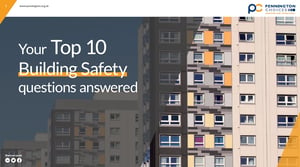Sign up to our newsletter
With 1st April fast approaching, the new building safety regime is almost upon us. From helping organisations across the sector to navigate the updates and ensure compliance with the Building Safety Act 2022, we’ve encountered a number of common misconceptions that have confused landlords. Our building safety experts have debunked these myths to ensure your next steps going into April are as smooth and straightforward as possible.
Listen to a clip from our recent building safety webinar, as our building safety expert, Stewart Kerr delves into myth-busting, addressing common misconceptions surrounding The Building Safety Act 2022.
Want to discover more about the updates coming in April? Our experts outlined everything you need to know to prepare in our latest webinar, ‘Building Safety Act 2022: Latest legislative updates’, which is available to watch now on-demand.
Myth: My building has six floors but is over 18 metres to the roof. Is it higher risk?
The definition of a higher-risk building is anything that’s 18 metres or higher, or seven storeys or more. You should refer to the full government guidance for detailed instructions on measuring your building's height.
To accurately measure building height, measurements must be taken from the floor slab of the highest residential floor, not its ceiling, and you must ignore:
- Any floor below ground level
- Any non-residential occupied area (plant room or ancillary room) at the top of the building
- The height of the roof
If you’re looking for a helping hand, our experts can provide measured surveys to give you the assurance that your building height has been measured correctly. Get in touch.
Myth: I don’t need to start getting my information together until the Building Safety Regulator (BSR) requests it.
No, it’s crucial that you start gathering your information now if you haven't already. Being prepared for the BSR's request in good time is essential as you'll only have 28 days to provide the necessary documents once called upon. Since creating a safety case report can be a long process, we advise starting early to be prepared.
Myth: Do I submit my safety case report(s) on 1st April?
No, you don't need to submit anything until the BSR requests it. To discover more about creating and submitting safety case reports, head over to our dedicated blog, 'Building Safety Case Report: What you should include'.
Myth: My building is single staircase. Do I need to consider adding a second staircase, as discussed within government?
No, adding a second staircase is only necessary if there is a particular reason to do so. For example, if a retrospective fire strategy or fire-engineered solution is required to improve the overall safety of the block and protect tenants.
Myth: Mandatory occurrence reporting is only for principal designers and principal contractors.
No, mandatory occurrence reporting is now open for everyone, including those in occupied buildings. Implementing a mandatory occurrence reporting process is crucial if you haven’t done so already. To assist with the development of this, you can access the government guidance here.
To discover more about mandatory occurrence reporting systems, head over to our blog, ‘Building Safety: The full regime approach’.
Myth: We are a managing agent and have been told by the building owner that we are the principal accountable person and need to complete the safety case report. Is that correct?
Maybe. This depends on contractual arrangements. Whilst building owners can organise for managing agents to undertake repairs and maintenance, this does not designate them as the accountable person or principal accountable person. This would only change if the details within the contract or lease specified that they would be managing and taking ownership of the block.
 Unsure who the principal accountable person for your building is? For further guidance on identifying accountable persons and principal accountable persons, download our free eBook, ‘Your Top 10 Building Safety Questions Answered’.
Unsure who the principal accountable person for your building is? For further guidance on identifying accountable persons and principal accountable persons, download our free eBook, ‘Your Top 10 Building Safety Questions Answered’.
Myth: Part of the building is rented out to a company, and we’ve determined they aren’t an accountable person, so can we ignore them and not include them in our safety case report?
No, you must consider all building users. If there’s an organisation renting out an area of the building, such as a commercial unit on the ground floor, you must liaise with them to check they are occupying that area safely and record this within your safety case report. It’s important to remember that the aim is to demonstrate that you're managing the whole building safely, not just the area you own and run.
Myth: I’m the manager in charge of day-to-day maintenance and repair. Am I an accountable person?
No. Whilst this will most likely make you a responsible person under the Regulatory Reform (Fire Safety) Order 2005, being responsible for maintenance doesn’t make you an accountable person.
Myth: We already have a resident engagement strategy for the organisation. Do I submit that with my safety case report?
No, an individual resident engagement strategy tailored specifically to each block must accompany the safety case report submission.
Myth: We already have a complaints procedure. Do we need a new one just for building safety?
Maybe. You can adapt existing complaints procedures, but you must ensure that building safety complaints are explicitly addressed in the procedure as they must be triaged and investigated. Escalated building safety complaints go to the BSR, not the Housing Ombudsman.
Myth: Does my Fire Risk Assessment (FRA) count as my building risk assessment?
No, the FRA focuses solely on fire-related risks and doesn't cover other risks, such as vehicle strikes, flooding, or neighbouring building hazards. Therefore, a comprehensive building risk assessment is essential.
.webp?width=600&height=150&name=Pennington%20Choices%20Logo%20(reduced).webp)







